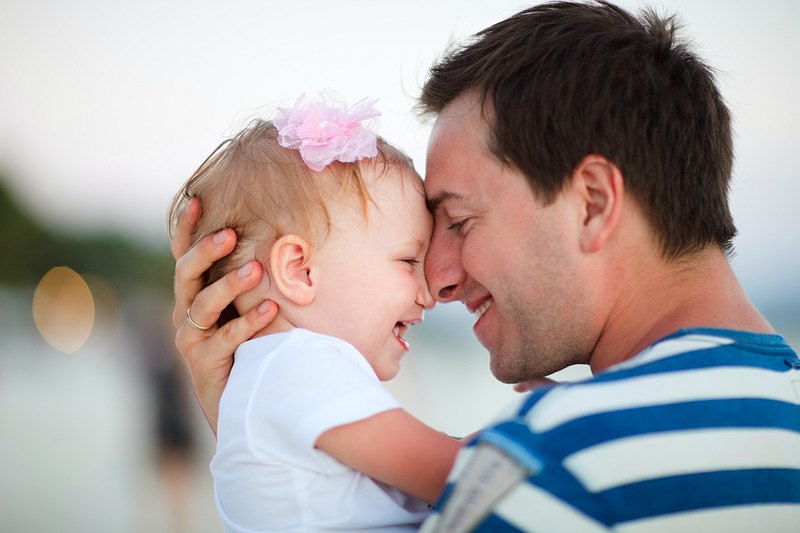The Importance of Fathers in the Child's Development (Continued)
Written by Craig Rogers, Posted on , in Section Relationships That Matter

What is a baby prepared to learn socially in the first 18 months?
Self-control of arousal (through the later-developing cortex) is not in place till after most of the first year, so keeping baby from over or under-arousal is largely up to the parent. Of course, the baby can do simple things like turn away or close eyes but the baby has limited capacities for self-calming. If these are unsuccessful the baby cannot self-calm.
"Dads can help baby stay calm with skin-to-skin carrying (a remarkable calming tool), rocking and patting, and other touch-plus-movement behaviors."
Face-to-face play between baby and parent becomes a clinical window on how the parent-child partnership is going: “It reveals when parenting is easy or hard, natural or forced, intrusive, controlling, disorganized, passive, aggressive, rejecting, etc.” Therapists who attend to these relational signals can use them to guide their treatment of the dyad. (Stern, 2010, pp. 106-7)
What is a baby prepared to learn socially in the first 18 months?
- Mutual eye gaze practices (how, how long, with whom)
- How to read postures
- How to solicit others for needs like food or play
- Rules of games
- Turn taking
- Greetings
- Joking
- Expressing affection
- Making friends
This knowledge is implicit relational knowing, nonconscious and nonverbal and is predominately processed in the right hemisphere, which rapidly develops in the first years of life. Parent “matching/mismatch of vitality forms can shape what the infant does and how he feels about doing it. It is like sculpting his mind from the inside out.” (Stern, 2010, p. 115)
What happens when babies don’t receive good mothering?
Two things happen: Babies experience toxic stress from the distress that arises when they don’t get what they need. For example, lack of comforting companionship care: they are left alone or left to cry (see Dangers of "Crying it Out" and Five Things NOT to do to babies)..
Second, babies don’t receive the appropriate stimulation to grow what is scheduled to grow at that time. Yes, human brains are plastic, but not that plastic: children can be left with gaps in various systems undergirding intelligence, physical health, mental health, social and moral capacities, which may not show up immediately but after further maturation that is dependent on those earlier foundations that are missing. These gaps are difficult if not impossible to repair later.
Daniel Stern asks why nature planned for babies not to speak or understand words for the first year or so of life. His answer is that they “have too much to learn about the basic processes and structures of interpersonal exchange. In particular, they have to learn the forms of dynamic flow that carry social behavior. In addition, they have to learn this before language arrives to mess it all up. The basic structures are all non-verbal, analogic, dynamic Gestalts that are not compatible with the discontinuous, digital, categorical nature of words.” (Stern, 2010, p. 110)
An illustration of the types of capacities early life experience develops, when the brain’s right hemisphere develops more rapidly,** is provided by Jill Bolke Taylor, neuroscientist. She described the sudden and unexpected right-hemisphere dominance she experienced after having a stroke in her left cerebral hemisphere: “Our right hemisphere is designed to remember things as they relate to one another. Borders between specific entities are softened, and complex mental collages can be recalled in their entirety as combinations of images, kinesthetic, and physiology.
To the right mind, no time exists other than the present moment, and each moment is vibrant with sensation. … the moment of now is timeless and abundant …The present moment is a time when everything and everyone are connected together as one. As a result, our right mind perceives each of us as equal members of the human family. It identifies our similarities and recognizes our relationship with this marvelous planet, which sustains our life. It perceives the big picture, how everything is related, and how we all join together to make up the whole. Our ability to be empathic, to walk in the shoes of another and feel their feelings, is a product of our right frontal cortex.” (2008, pp. 30-31).
"Human beings are complex creatures whose capacities are developed mostly after birth, unlike virtually every other animal. We need dads and grandfathers, along with moms and grandmothers and others, to provide the nurturing care, the mothering, that babies need to grow well."
*Note that womb experience also influences brain development and we can inherit some traits due to the experiences our grandparents had, like anxiety.
** The right hemisphere tends to process, filter and act on the world nonverbally, whereas the left hemisphere tends to house the areas of the brain related to verbal processing and expression.
For more about Darcia Narvaez Ph.D., click here.
